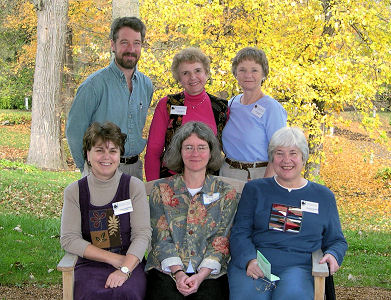A Vibrant Organization 26 Years Young
Founded in 1993, Indiana Native Plant Society (formerly the Indiana Native Plant & Wildflower Society) has grown robustly in both membership and wisdom while pursuing its mission. We celebrated our 25th Anniversary in 2018.
Accomplishments as of 2011
- Increased membership from 18 founding members in 1993 to more than 600 member families in 60 of Indiana’s 92 counties.
- Sponsored 21 plant sales and auctions, building a growing circle of native plant gardeners in central Indiana, and raising over $118,000 to further INPS’ mission.
- Developed slide shows, a website, the quarterly INPS Journal, and brochures to educate the public about INPS’ mission and the importance of native plants.
- Held annual conferences for members and the public, lending the expertise of key Indiana botanists and ecologists and bringing in the perspectives of such nationally known speakers as Doug Tallamy, Neil Diboll, Ken Druse, Jim Wilson, Floyd Swink, Andy Wasowski, Rick Darke, Bill Cullina, Tracy DiSabato-Aust, Donald J. Leopold, and Carole Summers.
- Initiated garden tours to homes, churches, and businesses that demonstrate the use of native plants in the landscape. Tours in 2010 and 2011 helped members and the general public plan their own gardens around native plants.
- Supported demonstration projects statewide with $20,000 in small grants. Gave $28,500 in large grants of $1,000 or more toward the purchase of lands to protect; helped WFYI produce its series, “Natural Heritage of Indiana”; helped the Brown County Public Library save its wooded ravine from invasive species; and supported research into the biocontrol of garlic mustard.
- Established Letha’s Youth Outdoors Fund in honor of Indiana’s “wildflower lady,” Letha Queisser, to make possible outings and projects that bring Indiana youth into contact with nature.
- Organized hikes and excursions to nature preserves, demonstration gardens, and research sites from Lake Michigan to the Ohio River and beyond, each led by experts in their fields.
- And more…
How INPS Got Its Start
Fall 1991: Avid gardener Carolyn Harstad speaks to the IMA Horticultural Society about wildflower propagation. She encourages the Hort Soc to organize a native plant society for Indiana, since there is none. She collects the names of a few interested persons. Later she would write the book, Go Native!
Winter 1992: Speaking to the IMA Horticultural Society about her upcoming book, Field Guide to Indiana Wildflowers, botanist-photographer Kay Yatskievych laments that Indiana is the only state east of the Mississippi without a native plant society. Ruth Ann Ingraham makes plans to call a meeting to form a native plant society, and she and Kay collect more names.
Spring 1992: Carolyn attends a Garden Club of Indiana wildflower workshop and meets club president Amy Little Mason of Terre Haute and speaker Dr. Michael Dana, a Purdue University professor of horticulture who has just returned from a sabbatical leave at the Lady Bird Johnson Wildflower Center in Austin, Texas. Both Amy and Mike have thought about organizing a native plant group and have their own lists of interested persons.
April 1993: Ruth Ann Ingraham invites key individuals to an organization meeting for a native plant society, held at the Marion County Cooperative Extension Office and chaired by Peter Harstad, executive director of the Indianapolis Historical Society.
The group lists possible goals and activities of a native plant society: Use native trees and shrubs. Understand how non-native plants can spread and become quite prevalent, particularly in natural areas. Promote native plantings in public spaces such as the IMA, the Water Company Canal, and White River State Park. Educate self and others. Organize plant rescue programs. Help people identify native plants. Conduct field trips. Promote maintenance of greenspace. Bring together a diverse group. Produce a newsletter. Create a strong political base for increased awareness. Work with INDOT and the highway department for “no spray” areas. Eliminate the stripping of seed sources by well-meaning people. Learn to utilize native plants in our gardens.
June 1993: At a meeting at Holliday Park, the Constitution and By-Laws are ratified and Indiana Native Plant and Wildflower Society is adopted as the official name. Charter members, paying yearly dues of $10, include Ruth Ann and Joe Ingraham, Carolyn and Peter Harstad, landscaper Bill Brink (Great Outdoors), Indianapolis Museum of Art horticulturists Sue Nord and Chris Turner, IMA director of the gardens and grounds Chuck Gleaves, Jeffrey Maddox, wildflower illustrator Jean Vietor, Lee Casebere, botanist Rebecca Dolan of Butler University, Becky Lomax, Anne Wilson, Bill McKnight of the Indiana Academy of Science, and Kay Yatskievych (now of Missouri Botanic Garden).
The society supports a vibrant first year: Members explore the wetland plants and ponds at Marian College, tour Purdue’s research plots of native forbs and grasses, and sponsor an auction, auctioneer Rolland Kontak presiding, that raises $1,080. INPAWS hosts a wine and cheese reception to honor Mike Homoya and Lee Casebere, author and photographer, respectively, of the newly released book, Orchids of Indiana; hikes in the remnant arboreal forest of Pine Hills Nature Preserve; and caps the year with a holiday celebration at the Harstad home. By year’s end, INPS has 149 members. The following spring, the first volume of the acclaimed newsletter rolls off the press, with the lead article entitled, appropriately enough, “First Signs of Spring,” by Kay Yatskievych.
These are excerpts of a detailed early history compiled by INPS historian Ruth Ann Ingraham on the occasion of INPS’ tenth anniversary in 2003. Read the complete story (PDF format).

